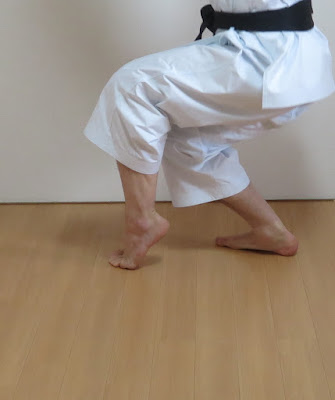 |
| The opening movement of 二十四歩 (Nijushiho) kata. |
Today, just a couple of brief notes on the basic applications of Kokutsu-dachi and Neko ashi-dachi.
KOKUTSU-DACHI: The ‘basic application’ kokutsu dachi is for escaping by
moving rearward, or on an angle; furthermore, it can be used (on the spot) to
simply transfer the weight rearwards—to subtly avoid an attack—then immediately
counterattack with a reverse transfer. Iida Norihiko Sensei’s mastery of this
strategy immediately comes to mind.NEKO ASHI-DACHI: Let’s compare kokutsu-dachi with the ‘basic application’ of neko ashi dachi… Likewise, neko ashi dachi is primarily an escaping stance, but it has a smaller base which is less stable—yet provides a more explosiveness and cat-like elusiveness (hence the stances name ‘cat leg’).
Of course, like all other tachikata, in freestyle practice we move through all of the stances (without stopping in the formalized set positions).
 |
| Second to last movement of 水手 (Suishu) kata. |
Which is better? Kokutsu dachi or Neko ashi dachi? Obviously,
it depends on the situation. Both of these stances concentrate their weight on
the rear leg; moreover, on lowering/sinking the weight to make their respective
techniques effective. In this way, they also allow us to concentrate on using
the power of the lower body and to relax the arms and shoulders. Needless to
say, this is an imperative fundamental skill in Karate-Do. In sum, both of
these stances, with majority of the weight on the rear leg, are absolutely essential kihon.
© André Bertel.
Oita City, Japan (2020).


No comments:
Post a Comment